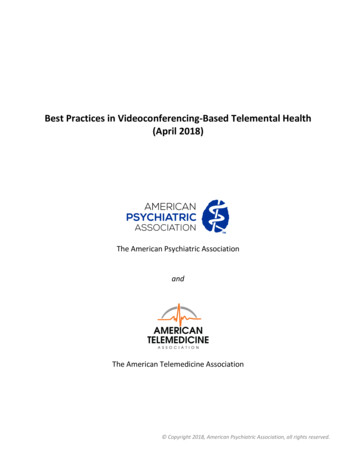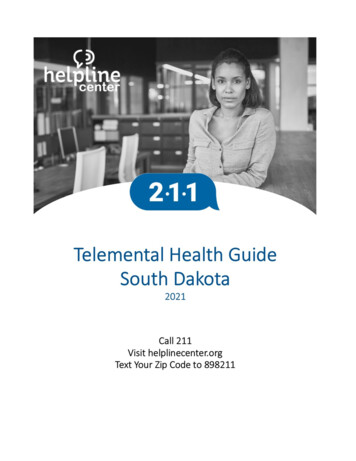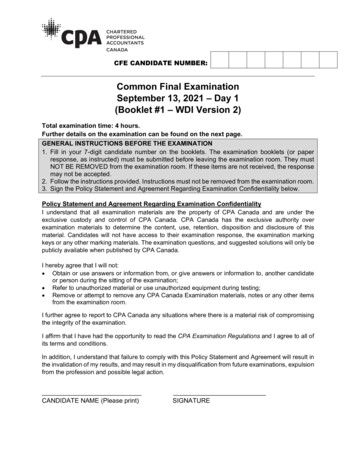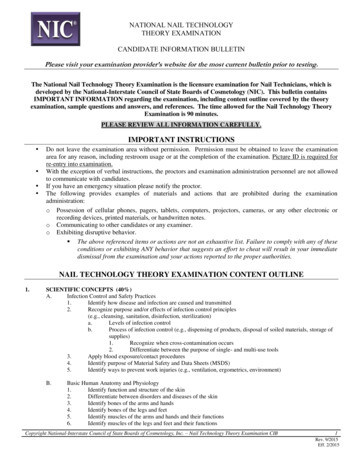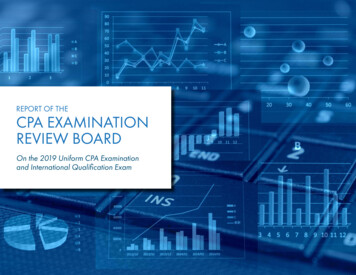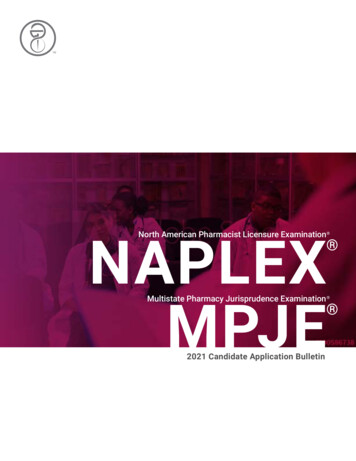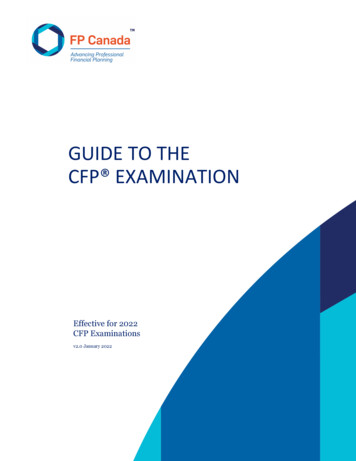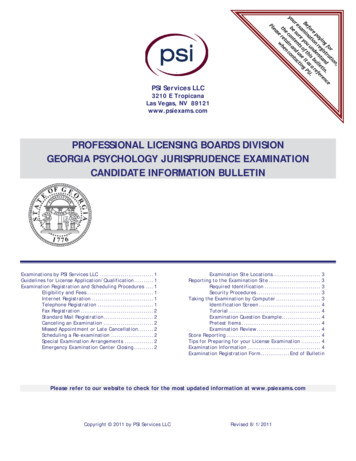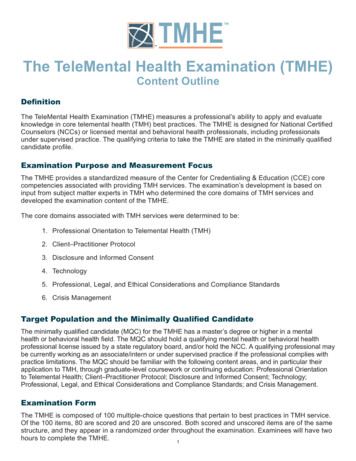
Transcription
TMHEThe TeleMental Health Examination (TMHE)Content OutlineDefinitionThe TeleMental Health Examination (TMHE) measures a professional’s ability to apply and evaluateknowledge in core telemental health (TMH) best practices. The TMHE is designed for National CertifiedCounselors (NCCs) or licensed mental and behavioral health professionals, including professionalsunder supervised practice. The qualifying criteria to take the TMHE are stated in the minimally qualifiedcandidate profile.Examination Purpose and Measurement FocusThe TMHE provides a standardized measure of the Center for Credentialing & Education (CCE) corecompetencies associated with providing TMH services. The examination’s development is based oninput from subject matter experts in TMH who determined the core domains of TMH services anddeveloped the examination content of the TMHE.The core domains associated with TMH services were determined to be:1. Professional Orientation to Telemental Health (TMH)2. Client–Practitioner Protocol3. Disclosure and Informed Consent4. Technology5. Professional, Legal, and Ethical Considerations and Compliance Standards6. Crisis ManagementTarget Population and the Minimally Qualified CandidateThe minimally qualified candidate (MQC) for the TMHE has a master’s degree or higher in a mentalhealth or behavioral health field. The MQC should hold a qualifying mental health or behavioral healthprofessional license issued by a state regulatory board, and/or hold the NCC. A qualifying professional maybe currently working as an associate/intern or under supervised practice if the professional complies withpractice limitations. The MQC should be familiar with the following content areas, and in particular theirapplication to TMH, through graduate-level coursework or continuing education: Professional Orientationto Telemental Health; Client–Practitioner Protocol; Disclosure and Informed Consent; Technology;Professional, Legal, and Ethical Considerations and Compliance Standards; and Crisis Management.Examination FormThe TMHE is composed of 100 multiple-choice questions that pertain to best practices in TMH service.Of the 100 items, 80 are scored and 20 are unscored. Both scored and unscored items are of the samestructure, and they appear in a randomized order throughout the examination. Examinees will have twohours to complete the TMHE.1
Development of the Content OutlineThe TMHE was developed by subject matter experts who possess vast experience in providing TMHservices. Working collaboratively, they identified the aspects of mental health and behavioral healthservices that were most impacted when practitioners are geographically separate from clients or whenservices to clients are provided asynchronously. For each domain identified, the skills and knowledgeareas corresponding to those domains were delineated. The resultant content outline was created andapproved by the TMHE Subject Matter Expert (SME) Committee in August 2020.The committee’s responsibilities included, but were not limited to, defining the TMHE; defining the MQCfor the TMHE; determining the examination format, length, and blueprint; and finalizing the content outline.Table 1 presents the six domains and the number of items on the TMHE for each domain.Table 1. The Number of Items for Each DomainDomainPercentage of ItemsNumber of Items1Professional Orientation toTelemental Health (TMH)10–208–162Client–Practitioner Protocol20–3016–243Disclosure and Informed sional, Legal, and Ethical Considerationsand Compliance Standards20–3016–246Crisis Management5–154–12*Note: The above item ranges reflect the distribution of the 80 scored items on the examination.The following core domains and associated skills and knowledge areas were identified by subjectmatter experts with experience in providing TMH services. These domains are supported by theTMH literature and existing education in TMH services.Table 2. Skills and Knowledge Areas Related to the Domains1. Professional Orientation to Telemental Health (TMH)SkillsA. Distinguish between various technologicalmodalitiesB. Use TMH as part of an integrative approachC. Implement the disclosure processD. Use ethical guidelines with social mediaE. Apply ethical practices to managepractitioner values and biasesKnowledge AreasF.G.H.I.J.K.L.Terminology relevant to TMHDifferences between TMH and non-TMH practiceThe public health need for TMHThe evolution of TMHThe different settings for TMH practiceThe TMH disclosure processThe ethical responsibility within thedisclosure processM. The ethical responsibilities toward ongoingtraining, knowledge, and supervision2
2. Client–Practitioner ProtocolSkillsKnowledge AreasA. Implement screening for suitability toengage in TMHB. Use ethically sound practices whenconducting appropriate screening and intakeC. Perform ongoing client risk assessmentsD. Demonstrate ethical responsibility forunderstanding how the client self-identifiesE. Conduct client assessment (general)F. Apply mental health theory and interventionsG. Conduct assessment of the client’spersonal resources and abilitiesH. Develop rapport with clientsI. Sustain appropriate clinician relationships/boundariesJ. Obtain and maintain proper documentationK. Implement and execute setting ofexpectations sessionsL. Evaluate ongoing effectiveness of TMHM. Demonstrate how to make appropriatereferralsN. Contraindications for TMHO. Ethics related to screening and intakeP. Risk factors (e.g., domestic violence, suicidality,homicidality)Q. Mental health theoriesR. Appropriate and effective TMH interventionsS. Client community resources in the geographicarea in which client livesT. Ethics and guidelines regarding clinicianrelationships/boundariesU. Proper documentationV. Ethics regarding documentationW. Scope of process of TMHX. National and client-local resourcesY. Ability to elicit information regarding clientresources and abilities in relation to TMHZ. Ability to develop rapport including recognitionof facial expressions and nonverbal communicationAA. Ability to implement assessmentsAB. Ability to use summaries, reflections, affirmations,and questions effectivelyAC. Ability to facilitate client’s cultural self-identification3. Disclosure and Informed ConsentSkillsA. Ensure the client understands the disclosuresand is able to provide informed consentB. Address the aspects of informed consent thatare specific to TMHC. Establish a protocol for social mediaD. Prepare a protocol for establishing localresources and an emergency contactE. Apply procedures for emergenciesF. Prepare a protocol for verification of identityG. Establish client identity prior to sessionH. Prepare a protocol for verification of locationI. Establish client location prior to sessionJ. Prepare a protocol for verification of privacyK. Establish client privacy prior to sessionL. Prepare a protocol for verification of safetyM. Establish client safety prior to sessionN. Prepare a protocol for management of technicaldifficultiesO. Explain unique challenges and risks of TMHP. Address concerns of clients related to TMHQ. Monitor ongoing informed consentKnowledge AreasR.S.T.U.V.W.X.Y.3Managing disclosures in TMHInformed consent process in TMHEthically gathering informed consentAppropriate use of social mediaElements of a safety planWhat is required to establish client identity in avirtual environmentUnique challenges and risks of TMH (e.g.,technology failure, confidentiality, privateconnection)Resources available to troubleshoot TMH issues
4. TechnologySkillsA. Explain the benefits and risks of differentTMH modalitiesB. Evaluate and select technologies for TMHC. Choose appropriate platform within chosenmodalityD. Implement chosen technologyE. Demonstrate to the client how to set upchosen technologyF. Instruct client of etiquette among differentmodalitiesG. Apply required technology security protocolsH. Demonstrate appropriate storage of sessionrecordings and documentationI. Demonstrate how to troubleshoot technicaldifficulties and poor quality of communicationKnowledge AreasJ.K.L.M.N.Ethical responsibilities regarding technologyEthical responsibility of confidentialityBenefits and risks of different TMH modalitiesDifferent platforms and modalitiesPractitioner TMH etiquette within differentmodalitiesO. Security aspects of different technologiesP. Terms related to technologyQ. Rules and regulations related to recordingsessions and documentationR. Ethical guidelines regarding the destruction ofsession recordings and documentationS. Hardware, software, and internet connectionneeds5. Professional, Legal, and Ethical Considerations andCompliance StandardsSkillsA. Apply privacy law requirements relatedto TMHB. Apply state and federal laws directingTMH practiceC. Apply HIPAA complianceD. Apply the Privacy RuleE. Apply the limits of malpracticeF. Demonstrate appropriate response tosecurity breachesG. Demonstrate appropriate response to data lossH. Apply setting-specific security needsI. Conduct technology risk assessmentKnowledge AreasJ.K.L.M.N.O.P.Q.R.S.T.U.V.W.X.Y.4Privacy law requirements related to TMHOrder of authority between state-level andfederal regulationsHIPAAHITECHCovered entities under HIPAAThe definition of Protected HealthInformation (PHI)Who can and cannot access PHIThe role of a privacy officerThe Patient’s Bill of RightsBusiness associate agreementsRisks of security breachesWhat constitutes a breachThe HIPAA Security RuleThe types of safeguards (technological,administrative, and physical) for risks and threatsThe consequences of non-complianceThe ethical responsibility regarding scope ofpractice
6. Crisis ManagementSkillsA. Create an emergency management planB. Assemble a list of active client-localemergency servicesC. Conduct ongoing verification of status ofclient-local emergency servicesD. Establish protocol to clarify bounds andrequirements of the practitioner whenclient is in crisisE. Assess if client is in crisisF. Employ de-escalation strategies in crisisG. Apply best practices in culturally appropriatecrisis interventionH. Demonstrate ability to manage involuntarycommitmentKnowledge AreasI.J.K.L.MN.The signs of crisisThe need for local supports (mobile teams,welfare/wellness checks)Systems and cultural context of local areaThe mental status of the clientThe benefits/consequences of specificinterventionsThe process of involuntary commitmentSample ItemsThe following sample items are provided as a representation of the sorts of questions that can be askedfrom the different competency areas.Domain 1: Professional Orientation to Telemental HealthWhich of the following illustrates a motivation in the need for telemental health (TMH) services?A.B.C.D.rising demand for TMH services in shortage areas with limited access to mental health providersgrowing preference for the use of TMH by counselors for ease and conveniencedevelopment of universal guidelines for TMH use for mental health professionalswider availability of Wi-Fi and higher speed internet connections to make use easierDomain 2: Client–Practitioner ProtocolWhich of the following illustrates why it is important to document the client’s residence?A.B.C.D.to ensure that your license is valid to provide TMH services in their stateto ensure that there isn’t a better counseling option for the clientto ensure that the client is always at their residence on recordto ensure your marketing analytics are congruent with campaignsDomain 3: Disclosure and Informed ConsentWhich of the following is the most likely location where a client will find the counselor’s statement onexpectations for telemental health counseling services?A.B.C.D.client assessment forminformed consent formprivacy policy documentrelease of information form5
Domain 4: TechnologyYou are upgrading your computers and plan to sell your old ones. Although you did store medicalrecords on the old computers, you copied that data over to the new computers. Which of the followingis the appropriate ethical action a telemental health provider should take before selling the oldercomputers?A.B.C.D.change the password on the computerscompletely wipe the hard drives, including all partitionsdelete all the electronic medical records dataremove the electronic medical records softwareDomain 5: Professional, Legal, and Ethical Considerations and Compliance StandardsWhich example could lead to a security breach?A. A videoconferencing platform is controlled by a third-party server that collects data from its users.B. A counselor scans the room remotely to ensure there is no one else in the teleconferencing roomwith the client.C. A counselor uses secure electronic messaging to communicate with a client between sessions.D. Electronic health records are accessible at the clinician site but not at the client site.Domain 6: Crisis ManagementPrior to the first counseling appointment, the counselor established the client’s location and verified theiridentity. Which of the following illustrates the next step in crisis management in telemental health (TMH)?A.B.C.D.ensure that insurance will pay for TMH servicescompile a list of the client’s local emergency servicescontact the emergency contact personstart the first counseling appointment with the clientQuestion NumberKey123456AABBAB6
Professional, Legal, and Ethical Considerations and Compliance Standards; and Crisis Management. Examination Form The TMHE is composed of 100 multiple-choice questions that pertain to best practices in TMH service. Of the 100 items, 80 are scored and 20 are unscored. Both scored and unscored items are of the same


